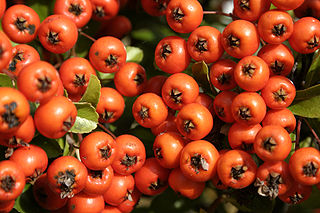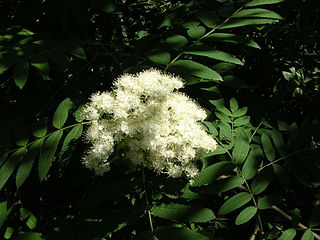
 I was feeling rather smug about my identification of a new magical tree, when I learned that the American Mountain Ash is a New World subspecies of the rowan tree. Oh well.Every beginning magic student hears about the rowan tree. The tree with magic berries, protected by a dragon. The source of the best wands. The tree of strong protection, which banishes lightening. The tree of vision. Both saints and heroes had some of their most extraordinary revelations under the rowan tree. “What’s a rowan tree?” I recall asking on more than one occasion. The response would be, “Oh, it’s some tree that grows in England, and it [recites a litany of magical qualities].” Why didn’t anyone tell me that the rowan is the Mountain Ash? Because they didn’t know. Because most of us learn about witchcraft in urban settings. Because I was studying in California, and the Mountain Ash doesn’t grow there any more than the rowan does. Because the study of magic has gotten lost in its abstractions. This is one of the reasons I started the Yellow Birch School of Magic, because I wanted to connect pagans with the tangible foundations of magical practice.The rowan is the tree for the second month of the Celtic tree calendar. Says Robert Graves, “The important Celtic feast of Candlemas fell in the middle of it (February 2). It was held to mark the quickening of the year…” Quickening refers to the point in the pregnancy where fetal movements can be felt by the mother. In folklore it is believed to be the time when the spirit incarnates in the growing fetus. Graves goes on to say “Since it was the tree of quickening, it could also be used in a contrary sense. In Danaan Ireland a rowan-stake hammered through a corpse immobilized its ghost; and in the Cuchulain saga three hags spitted a dog, Cuchulain’s sacred animal, on rowan twigs to procure his death.”By identifying the rowan tree with Candlemass, I have given away the link between this tree and the Celtic goddess Brigid. February 2nd is also known as “Brigid’s Day.” Brigid is the Celtic fire goddess. Patricia Monaghan says of her pre-Christian worship, “She may have been seen as a bringer of civilization, rather like other Indo-European hearth goddesses (Vesta, Hestia) who ruled the social contract from their position in the heart and hearth of each home.” Fire is associated with vision, and Brigid’s Day is a day for divination, particularly weather divination. This is why the groundhog sees or doesn’t see his shadow on this day. And how is the rowan tree connected with fire? For that we have to go back to those little orange berries, the color of a warm fire.SourcesGraves, Robert. The White Goddess. New York: Farrar, Straus and Giroux, 1966.Ketchledge, E.H. Forests and Tress of the Adirondack High Peaks Region. Lake George, NY: Adirondack Mountain Club, 1967.Monaghan, Patricia. The Encyclopedia of Celtic Mythology and Folklore. New York: Checkmark Books, 2008.Ristic, Radomir. Balkan Traditional Witchcraft. Trans. Michael C. Carter, Jr. Sunland, CA: Pendraig, 2009.Tree Encyclopedia. American Mountain Ash – Sorbus americana
I was feeling rather smug about my identification of a new magical tree, when I learned that the American Mountain Ash is a New World subspecies of the rowan tree. Oh well.Every beginning magic student hears about the rowan tree. The tree with magic berries, protected by a dragon. The source of the best wands. The tree of strong protection, which banishes lightening. The tree of vision. Both saints and heroes had some of their most extraordinary revelations under the rowan tree. “What’s a rowan tree?” I recall asking on more than one occasion. The response would be, “Oh, it’s some tree that grows in England, and it [recites a litany of magical qualities].” Why didn’t anyone tell me that the rowan is the Mountain Ash? Because they didn’t know. Because most of us learn about witchcraft in urban settings. Because I was studying in California, and the Mountain Ash doesn’t grow there any more than the rowan does. Because the study of magic has gotten lost in its abstractions. This is one of the reasons I started the Yellow Birch School of Magic, because I wanted to connect pagans with the tangible foundations of magical practice.The rowan is the tree for the second month of the Celtic tree calendar. Says Robert Graves, “The important Celtic feast of Candlemas fell in the middle of it (February 2). It was held to mark the quickening of the year…” Quickening refers to the point in the pregnancy where fetal movements can be felt by the mother. In folklore it is believed to be the time when the spirit incarnates in the growing fetus. Graves goes on to say “Since it was the tree of quickening, it could also be used in a contrary sense. In Danaan Ireland a rowan-stake hammered through a corpse immobilized its ghost; and in the Cuchulain saga three hags spitted a dog, Cuchulain’s sacred animal, on rowan twigs to procure his death.”By identifying the rowan tree with Candlemass, I have given away the link between this tree and the Celtic goddess Brigid. February 2nd is also known as “Brigid’s Day.” Brigid is the Celtic fire goddess. Patricia Monaghan says of her pre-Christian worship, “She may have been seen as a bringer of civilization, rather like other Indo-European hearth goddesses (Vesta, Hestia) who ruled the social contract from their position in the heart and hearth of each home.” Fire is associated with vision, and Brigid’s Day is a day for divination, particularly weather divination. This is why the groundhog sees or doesn’t see his shadow on this day. And how is the rowan tree connected with fire? For that we have to go back to those little orange berries, the color of a warm fire.SourcesGraves, Robert. The White Goddess. New York: Farrar, Straus and Giroux, 1966.Ketchledge, E.H. Forests and Tress of the Adirondack High Peaks Region. Lake George, NY: Adirondack Mountain Club, 1967.Monaghan, Patricia. The Encyclopedia of Celtic Mythology and Folklore. New York: Checkmark Books, 2008.Ristic, Radomir. Balkan Traditional Witchcraft. Trans. Michael C. Carter, Jr. Sunland, CA: Pendraig, 2009.Tree Encyclopedia. American Mountain Ash – Sorbus americana
